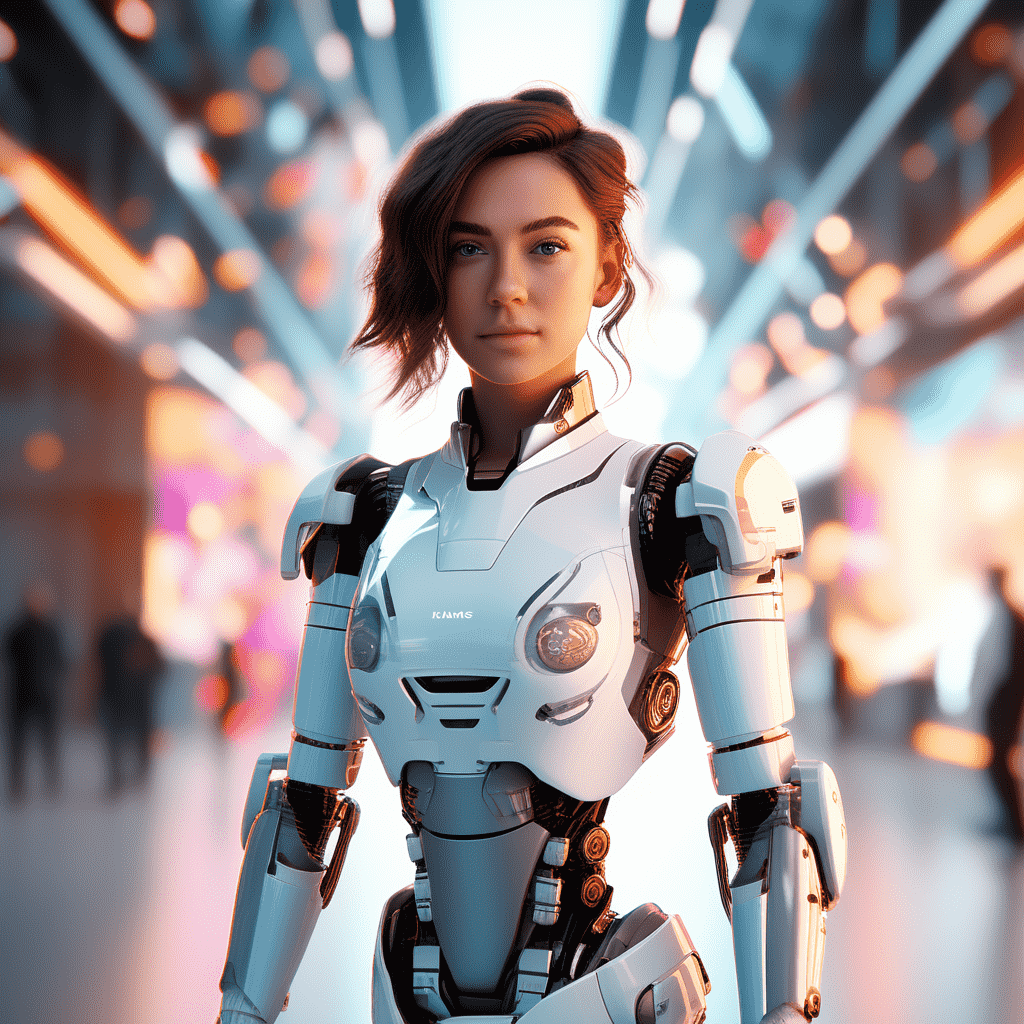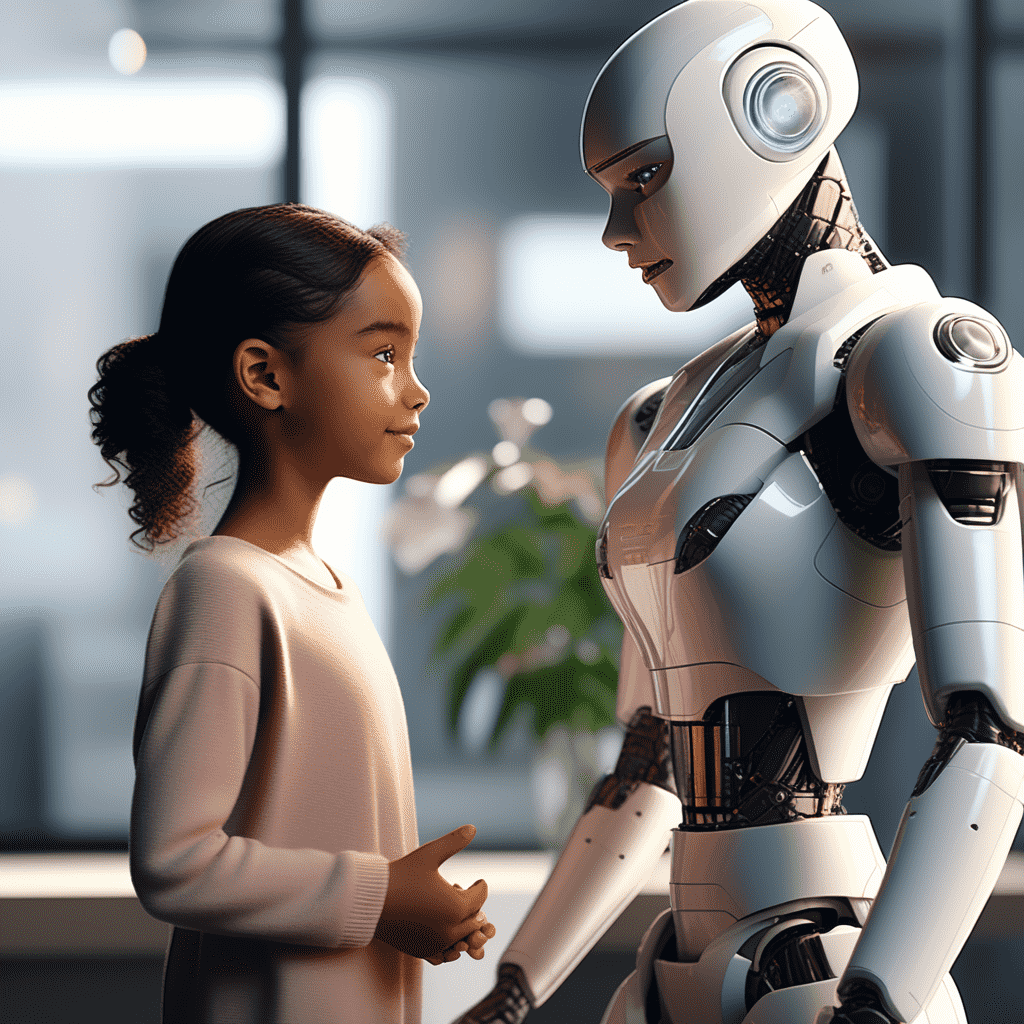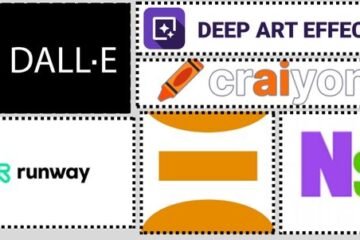Understanding Character AI and Its Impact on Technology

Character AI, or Character Artificial Intelligence, represents a groundbreaking approach in the realm of digital interactions, blending complex algorithms with elements of machine learning to create virtual entities that can engage with users in a deeply personalized manner. This sophisticated form of AI simulates human-like interactions, learning and evolving based on the data it processes, thereby revolutionizing the way we interact with technology on various platforms.
The Emergence of Character AI has marked a significant evolution in the tech industry, fundamentally altering user experiences and engagement strategies. From virtual assistants that manage daily tasks with a personal touch to advanced chatbots facilitating customer service with unprecedented efficiency, Character AI has seamlessly integrated into our digital lives, setting new standards for interactive technology.
The Impact on Technology and Society goes beyond mere convenience. Character AI fosters a more intuitive, human-centric approach to technological design, emphasizing empathy and understanding. It transforms user interaction from transactional to relational, building a sense of connection and trust between humans and machines. This shift has profound implications for industries ranging from education and healthcare, where personalized AI tutors and patient care bots are becoming increasingly prevalent, to entertainment, where AI-driven characters offer immersive experiences in gaming and virtual reality.
Moreover, Character AI challenges and inspires developers and creators to push the boundaries of what’s possible, ushering in a new era of innovation and creativity. Its application in creating dynamic, responsive virtual worlds and characters enhances storytelling, making narratives more engaging and interactive.
However, the ascent of Character AI also prompts important ethical considerations. As these AI characters become more indistinguishable from humans in their interactions, questions about privacy, security, and the psychological effects of deeply personalized AI interactions come to the forefront. It is crucial for developers and society at large to navigate these challenges thoughtfully, ensuring that Character AI serves to enhance human life without compromising our values or well-being.
In conclusion, Character AI stands at the forefront of a technological revolution, shaping the future of how we interact with the digital world. Its ability to offer personalized, human-like engagements presents both vast opportunities and significant challenges, heralding a new age of innovation while emphasizing the need for ethical stewardship in the development and application of AI technologies.
.
Understanding the Science Behind Emotion Recognition in AI
Emotion recognition technology, a groundbreaking advancement in artificial intelligence (AI), is reshaping how machines understand and interact with humans. At its core, this technology analyzes various human inputs such as facial expressions, voice intonations, and even body language to interpret emotional states. The science behind it is not only fascinating but also intricate, involving a blend of computer science, psychology, and cognitive science.

The Fundamentals of Emotion Recognition
At the heart of emotion recognition in AI, algorithms play a critical role. These algorithms are trained on extensive datasets containing images, video, and audio samples that are labeled with different emotions. By employing machine learning techniques, particularly deep learning, these algorithms learn to identify patterns and nuances in expressions or speech that correspond to specific emotional states.
Facial Expression Analysis: One of the primary methods used in emotion recognition. AI systems use facial recognition technology to detect key features on the face such as the position of the eyebrows, the shape of the mouth, and the openness of the eyes. Each of these features can indicate various emotions. For instance, raised eyebrows and a wide mouth might suggest surprise, while frowned eyebrows and a closed mouth might indicate anger.
Voice Intonation Processing: Equally important is the analysis of voice intonation. AI systems are adept at processing speech to detect subtle variations in tone, pitch, and speed, which can reveal the speaker’s emotional state. A high pitch and rapid speech might denote excitement or anxiety, whereas a low pitch and slow pace might suggest sadness or disinterest.
Sentiment Analysis in Text Messages: Beyond facial and vocal cues, emotion recognition technology extends its capabilities to written text. Through sentiment analysis, AI evaluates the choice of words, sentence structure, and punctuation to ascertain the underlying emotion. This facet is particularly useful in enhancing customer service chatbots and social media monitoring.
The interdisciplinary approach to developing emotion recognition technology underscores its complexity and efficiency. It encapsulates not just the technical prowess of machine learning models but also a deep understanding of human psychology. As this technology advances, it promises more nuanced and empathetic interactions between machines and humans, propelling us towards a future where AI understands not just our commands but also our emotions.
In summary, emotion recognition in AI is a testament to how far technology has come in bridging the gap between human emotions and machine understanding. It’s a fascinating domain that seamlessly integrates science, technology, and psychology to enhance human-machine interactions significantly.
The Impact and Evolution of Character AI in Video Games
In the world of video games, the introduction and evolution of Character AI (Artificial Intelligence) have marked a pivotal change in gaming experiences, creating environments that are more immersive, realistic, and engaging. With the advancement of technology, the role of Character AI in video games has transitioned from mere background elements to complex entities that can think, learn, and interact with players in ways that were once unimaginable.

The Basis of Character AI in Gaming
Character AI in video games operates on algorithms and programming that allow non-player characters (NPCs) to make decisions, adapt to player actions, and even develop over time. These artificially intelligent characters can range from enemies with strategic attack patterns to allies with dynamic support tactics, each designed to enhance the gaming experience by adding depth and realism.
Enhancing Realism and Immersion One of the key roles of Character AI in video games is to enhance the sense of realism and immersion. Through sophisticated AI programming, NPCs can exhibit behaviors and emotions closely mirroring humans or appropriate to their character design, thereby creating a more believable and engaging world. For example, in games like The Witcher 3: Wild Hunt , NPCs have daily routines, react to weather changes, and can engage in meaningful conversations with the player, adding layers of depth to the game’s world. Adaptive Challenges and Gameplay Dynamics Moreover, Character AI significantly contributes to the dynamic nature of gameplay. AI-driven characters can adapt their strategies in response to player actions, creating a challenging and unpredictable gaming experience. Through learning algorithms, some games allow enemies to remember player tactics and counteract them in future encounters, demanding players to evolve and adapt their strategies to progress. The Future of Character AI in Video Games As we look towards the future, the potential of Character AI in video games is vast and exciting. With developments in machine learning and neural networks, we anticipate seeing NPCs with even greater levels of autonomy and complexity. This evolution promises to deliver deeper narrative experiences, where character interactions and storylines adapt uniquely to individual player actions, paving the way for personalized gaming experiences that are as varied as the players themselves. In conclusion, the role of Character AI in video games cannot be overstated. It is a cornerstone of game design that enriches player experience by creating a dynamic, immersive, and realistic world. As technology advances, the capabilities of Character AI will continue to grow, promising even more engaging and lifelike virtual environments for players to explore.Implementing Emotional Intelligence in Virtual Assistants

In the rapidly evolving landscape of artificial intelligence (AI), the integration of Emotional Intelligence (EI) within virtual assistants stands out as a transformative step towards more personalized, understanding, and effective user interactions. Emotional intelligence, defined as the ability to recognize, understand, and manage not only one’s own emotions but also those of others, can significantly elevate the performance and user satisfaction of AI-driven virtual assistants.
Why Emotional Intelligence Matters
Virtual assistants, from Siri and Alexa to more specialized chatbots, have become ubiquitous in our daily lives; assisting with tasks, providing information, and even offering companionship. Despite their widespread use, a common critique has been their lack of genuine understanding or empathy – a gap that emotional intelligence seeks to bridge. By imbuing these digital helpers with the capability to analyze and respond to the emotional state of the user, the interaction becomes more engaging, meaningful, and helpful.
• Real-Time Emotion Recognition – By leveraging advancements in natural language processing and sentiment analysis, virtual assistants can now interpret the emotional context of user inputs with greater accuracy. This enables them to tailor responses that are not only contextually appropriate but emotionally resonant as well. • Adaptive Response Generation – It’s not just about understanding the emotion but also about responding in a way that reflects an understanding of that emotional state. Whether it’s offering words of encouragement, expressing empathy, or inserting appropriate humor, emotionally intelligent virtual assistants can vastly improve user experience. • Personalized User Engagement – Emotional intelligence allows virtual assistants to remember and learn from past interactions, leading to more personalized and meaningful future interactions. This heightened level of personalization fosters a deeper connection between users and their virtual assistants, transforming a purely transactional relationship into a more relational one. The Path Forward The implementation of emotional intelligence in virtual assistants marks a significant leap forward in making technology more human-centric. It’s not merely about making machines smarter; it’s about making them more attuned to the complexities and nuances of human emotions. This empathetic approach not only enhances user satisfaction but also opens up new avenues for virtual assistants, extending their utility in fields such as mental health, customer service, and education. As developers and innovators continue to refine these emotionally intelligent systems, the potential for creating more meaningful, understanding, and helpful AI interactions seems boundless. The future of virtual assistants looks not just smarter, but more empathetic, signaling a new era of AI that’s truly attuned to the human experience.Ethical Considerations in Character AI Development
The advent of Character AI development has ushered in a new era of interactive technology, blending creativity with computing to create lifelike characters that can think, learn, and even evolve. As these digital entities become more sophisticated, ethical considerations must take center stage to ensure that their development and deployment are done responsibly.

The Essence of Ethical AI Characters
Creating AI characters that are ethical not only involves the technology behind them but also the intention, context, and potential impact they have on users and society at large. Ethical considerations in AI character development encompass a broad spectrum of concerns, from privacy and consent to the portrayal of gender, race, and cultural sensitivities.
Privacy and Data Security : At the heart of ethical AI is the unwavering commitment to protect user data. AI characters, by design, learn from interactions, raising significant privacy concerns. Developers must ensure that data collection is transparent, consensual, and secure, safeguarding users against breaches and undesired privacy intrusions.
Preventing Bias : AI systems learn from vast datasets, and if these datasets contain biases, the AI characters are likely to replicate or even amplify them. Ensuring that character AI is developed using diverse, unbiased datasets is crucial in preventing discriminatory behavior or stereotyping, fostering an environment of inclusivity and respect.
Authentic Representation : Ethically developed AI characters should avoid perpetuating harmful stereotypes and instead aim for authentic, diverse representations. This involves thoughtful character design and narrative choices that reflect a wide range of human experiences and cultures, promoting positive identification and empathy amongst users.
Developers must consider the long-term effects of interaction with AI characters, particularly regarding emotional dependency or the blurring of lines between virtual and real relationships. Establishing ethical guidelines that prioritize users’ mental and emotional well-being is essential.
Transparency and Accountability: Finally, transparent communication about how AI characters work, their limitations, and the values they embody reassures users and builds trust. Developers must be accountable for their creations, ready to address unforeseen consequences and implement changes when necessary.
In conclusion, the development of character AI presents a unique blend of technological innovation and artistic expression, entwined with profound ethical implications. As we stand on the brink of a future populated by digital beings, striving for ethical integrity in their creation ensures that this future is not only technologically advanced but also morally grounded, benefiting society as a whole.
The Future of Character AI in Film and Entertainment
The landscape of film and entertainment is on the cusp of a revolution, heralded by the advancement of Character AI. This technology, leveraging the power of artificial intelligence, is set to redefine the way characters are created, animated, and even perform in movies, video games, and virtual reality experiences. As we gaze into the future, the potentials seem boundless, promising more immersive and emotionally engaging content.
Character AI is transcending the traditional boundaries of animation and performance capture. It is evolving into a sophisticated tool that can generate hyper-realistic characters who can think, learn, and interact with their environment and audience in real time. This progression signifies a monumental shift from static, script-bound entities to dynamic beings capable of improvisation, a trait once exclusively human.The Implications for Storytelling and Interaction
Imagine a film where characters can adapt their dialogue and actions based on audience reactions or a video game with NPCs (Non-Player Characters) that can strategize in real-time against players, creating an unparalleled level of challenge and engagement. The narrative depth achievable when characters can evolve through AI, learning from interactions within their stories, is profound. They can develop more nuanced personalities, backstories, and emotional arcs, making stories more gripping and relatable.
Moreover, Character AI can drastically reduce the costs and timeframes associated with high-quality animation and character development. Through procedural generation techniques, characters and their animations can be created much faster, without compromising quality, allowing for richer, more detailed worlds within films and games. Ethical Considerations and Creativity As we embrace the future of Character AI, ethical considerations come to the fore. The authenticity of performances and the role of human actors in the industry may be questioned. However, this technology also opens up new avenues for creativity and collaboration, blending the artistry of human performance with the innovation of AI, leading to unprecedented forms of storytelling. Importantly, Character AI is not just a technological feat but a canvas for creative expression. It empowers creators to bring to life complex, believable characters that were once confined to the imagination. The future of film and entertainment, enriched with Character AI, is not merely about technological advancement but about deepening our connection to stories and the characters that bring them to life. As we move forward, the fusion of technology and creativity heralds a new era of storytelling that is as boundless as our imagination.
Understanding the Emotional Bond Between Humans and AI Characters

In the increasingly digital era, Artificial Intelligence (AI) characters are no longer confined to the realms of science fiction and gaming. These virtual entities have woven their way into the fabric of everyday life, engaging with us through social media, mobile apps, video games, and as part of therapeutic interventions. Central to this interaction is the psychological phenomenon of emotional engagement — the process through which humans develop attachments, sometimes profound, toward AI characters. This connection highlights the intricate interplay between human emotions and digital companionship.
The concept of emotional engagement with AI characters rests on the principles of empathy and anthropomorphism. Humans are naturally inclined to empathize with beings that exhibit emotions, whether joy, sorrow, or fear. When AI characters are designed to express or simulate these emotions, it activates our empathetic responses, blurring the line between artificial and authentic emotional exchange. Furthermore, anthropomorphism, the attribution of human characteristics to non-human entities, plays a crucial role. As we interact with these digital personas, we subconsciously endow them with human qualities, fostering a sense of relatability and companionship.
Several factors influence the depth of emotional engagement with AI characters:
• Personality Match: Much like human relationships, compatibility in terms of personality can enhance the connection between humans and AI characters. A user might feel more attached to an AI that mirrors their temperament or exhibits qualities they admire.
• Emotional Intelligence: AI characters with higher levels of emotional intelligence can better understand and respond to a user’s emotional state, creating a more meaningful and supportive interaction.
• Contextual Interaction: The context in which these interactions occur also impacts emotional engagement. AI characters in therapeutic settings, for instance, are designed to offer support and empathy, fostering a deeper emotional bond.
• Narrative Involvement: In video games and interactive storytelling, the narrative involvement allows users to project themselves into the story through AI characters, enhancing emotional investment.
The psychological effects of engaging with AI characters are multifaceted. On one hand, these digital companions can provide emotional support, reduce feelings of loneliness, and serve as a practice ground for social interactions. On the other hand, overattachment or preferring AI interaction over human contact could pose challenges, highlighting the importance of balance.
In summary, the emotional engagement between humans and AI characters is a complex interplay reflective of our innate desire for connection and understanding. As AI technology evolves, fostering healthy and meaningful interactions will be crucial for maximizing the benefits while minimizing potential adverse effects. Our journey alongside AI characters is not just about technological advancement but also about exploring the depths of human empathy and connection.
Successful Integration of Character AI in Real-World Applications

The advent of Character AI has revolutionized numerous sectors, transforming how businesses interact with their customers and automate processes. This cutting-edge technology, leveraging advanced algorithms and deep learning, enables characters powered by AI to understand, learn, and respond in human-like manners. The seamless integration of Character AI across various industries not only enhances user engagement but also drives operational efficiency, providing a competitive edge in today’s fast-paced market.
One notable application of Character AI is in the Customer Service Industry. Companies have deployed AI-powered chatbots that can handle inquiries and provide instant responses round the clock. Unlike traditional bots, these AI characters can decipher complex queries, detect emotional cues, and respond empathetically, significantly improving customer satisfaction. A prime example is a telecom giant that introduced an AI character named “Eva.” Eva interacts with customers, solving common issues and guiding them through services, resulting in a dramatic reduction in response time and an increase in resolutions on the first contact.
In the Entertainment and Gaming Sector, Character AI has been a game-changer. Video game developers have introduced characters with advanced AI, capable of dynamic interactions and decision-making, offering a more immersive and personalized gaming experience. These characters adapt to the player’s style, making each gameplay unique and engaging. Additionally, in virtual reality experiences, AI characters serve as guides or companions, enhancing the realism and depth of interactive sessions.
The Educational Field also benefits from Character AI, where it serves as an intriguing tool for engaging students. Virtual tutors equipped with AI capabilities can offer customized learning experiences, adjust teaching methods based on the student’s progress, and provide instant feedback. This tailored approach helps in retaining interest and improving the understanding of complex subjects.
Moreover, in Healthcare, AI characters are revolutionizing patient care by offering virtual consultations. These AI health assistants can assess symptoms, provide basic diagnostics, and even remind patients to take their medicine, thereby extending the reach of healthcare services and reducing the burden on medical professionals.
The successful deployment of Character AI across these sectors underscores its potential to enhance not only user experiences but also operational effectiveness. As technology advances, the integration of Character AI in real-world applications is set to expand, opening new frontiers for innovation and interaction.
The future of Character AI holds immense potential, and its ongoing development promises to introduce even more sophisticated applications. This not only signifies a leap towards more human-like AI but also marks a shift in how industries perceive and implement automation and customer interaction strategies.
Frequently Asked Questions (FAQs)
Q1. What is Character AI, and how does it impact digital interactions?
A1. Character AI, or Character Artificial Intelligence, combines algorithms and machine learning to create virtual entities that personalize digital interactions. It revolutionizes user experiences, from managing daily tasks to enhancing customer service and fostering a human-centric approach to technological design.
Q2. What ethical considerations arise with the ascent of Character AI?
A2. Privacy, security, and psychological effects become crucial ethical considerations. Developers and society must navigate challenges thoughtfully, ensuring Character AI enhances human life without compromising values or well-being.
Q3. How does Emotion Recognition in AI work, particularly in facial expression analysis and voice intonation processing?
A3. Emotion Recognition in AI uses algorithms trained on labeled datasets. Facial expression analysis detects key features, while voice intonation processing analyzes tone, pitch, and speed to interpret emotional states.
Q4. What role does Character AI play in video games, and how does it enhance realism and immersion?
A4. Character AI in video games operates on algorithms allowing NPCs to make decisions, adapt to player actions, and enhance realism. It contributes to dynamic gameplay, adapting strategies and promising future developments for more autonomy and complexity.
Q5. Why does Emotional Intelligence matter in virtual assistants, and how does it improve user engagement?
A5. Emotional Intelligence in virtual assistants enhances user interaction by recognizing and responding to emotional states in real-time. It enables adaptive response generation, personalized user engagement, and marks a transformative step towards more meaningful AI interactions.
Q6. Can Character AI see your messages?
A6. No, Character AI does not have the capability to see or interpret messages. It operates based on algorithms and predefined patterns to provide personalized interactions without accessing private messages.
Q7. What is not allowed on Character AI?
A7. Content that violates ethical standards, promotes harm, or breaches privacy is not allowed on Character AI. Developers enforce guidelines to ensure responsible use and positive user experiences.
Q8. Is it safe to use Character AI?
A8. Yes, using Character AI is generally safe. Developers prioritize user safety and implement security measures to protect personal information, ensuring a secure and positive interaction experience.
Q9. Is NSFW (Not Safe For Work) content allowed with Character AI?
A9. No, NSFW content is not allowed with Character AI.
Developers enforce strict content guidelines to maintain a safe and appropriate environment for users, aligning with ethical standards.




0 Comments